

Waste is any substance or object that the holder intends to, or is required to discard. Radioactive waste contains radioactivity above certain levels defined in legislation.
In the UK, we use radioactive materials for a range of purposes, such as generating power, treating medical illnesses and conducting research. These processes often generate waste as a by-product.
Items that have no further use and are contaminated or activated by radioactivity above certain levels defined in legislation, are known as radioactive wastes.
Some radioactive substances or objects are not classed as waste because they may be useful in the future. For example, reprocessing spent (used) nuclear fuels can recover uranium and plutonium for producing new fuel. At present, these materials are safely stored in case there is a need for them in future. If the UK government decides that these materials have no future use, they will reclassify the material as waste. The UK government will make this decision based on many aspects, such as economic, environmental and safety grounds.
Items can become contaminated or activated by radioactive materials. Contamination can potentially occur wherever there are radioactive materials, but activation can only occur in the presence of a strong neutron emitter.
Contamination When we use radioactive materials, some of this material will inevitably transfer to the things they touch. This causes their surfaces to become ‘contaminated’. Eventually these contaminated items will be managed as radioactive waste. Examples include used equipment, tools and protective clothing that are contaminated by radioactive materials. In nuclear power reactors, normal operations lead to the contamination of internal components, such as tanks and pipes.
Activation Items can also become radioactive if they come into contact with (or close to) a strong source of neutron radiation. The neutrons interact with atoms in the material, causing them to become unstable. The unstable atoms then split apart and release further radiation. These items are ‘activated’ by radiation and are now radioactive themselves. This can occur on both the surface and inside the object. For example, graphite in the core of a nuclear power reactor is activated during normal operations.

We need a good understanding of what radioactive waste is, so we can manage it safely and effectively.
Today, waste producers must keep detailed records about all their activities. This provides us with good information about new wastes that are arising. There are few detailed records for some wastes that were produced a long time ago (legacy wastes) which makes understanding what we need to manage more challenging.
All radioactive wastes need to be ‘characterised’. This means collecting information about the radiological, chemical and physical properties of the waste. This information helps sites when deciding how to safely handle, package, store and dispose of the waste.
Waste producers characterise their wastes by:
Radioactive waste characterisation is important, but it can also be expensive. Waste producers must prioritise which wastes need to be assessed first.
Every 3 years, the Department for Business, Energy and Industrial Strategy (BEIS) and the Nuclear Decommissioning Authority (NDA) publish reports on the UK’s Radioactive Waste and Materials Inventory. These reports provide information on the amount of radioactive waste that exists now and the estimated amount that will arise in the future. It also includes information about radioactive materials; these items are not classed as waste because they may be useful in the future. If the UK government decides that these materials have no future use, they will reclassify the material as waste. Wastes from new nuclear power stations are not currently included in the UK Radioactive Waste and Materials Inventory.
The latest UK Radioactive Waste and Materials Inventory provides information about wastes that were in stock at 1st April 2016 and estimated to arise after this date. In the UK, England produces around 91% of all radioactive wastes by volume, with 6% in Scotland and 3% in Wales. There are no major producers of radioactive waste in Northern Ireland.
Find out more about the UK Radioactive Waste and Materials Inventory
2019 UK Radioactive Waste and Materials Inventory reports
Find out more about how radioactive waste is produced
Download our factsheets to learn more about radioactive waste